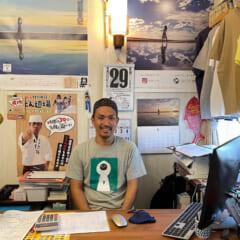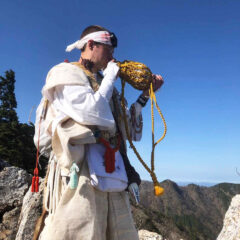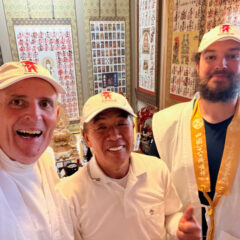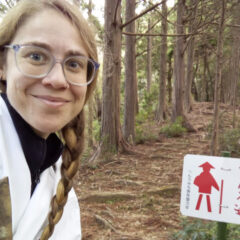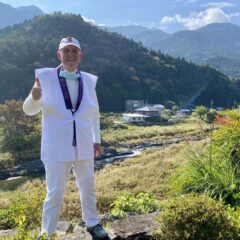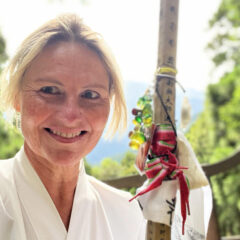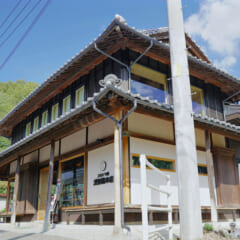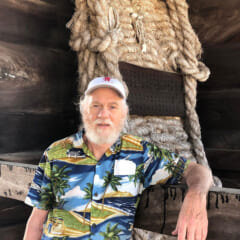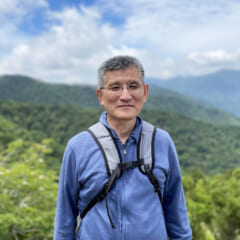Shikoku Pilgrims’ Helpers (2) English Map Author: Mr. Matsushita
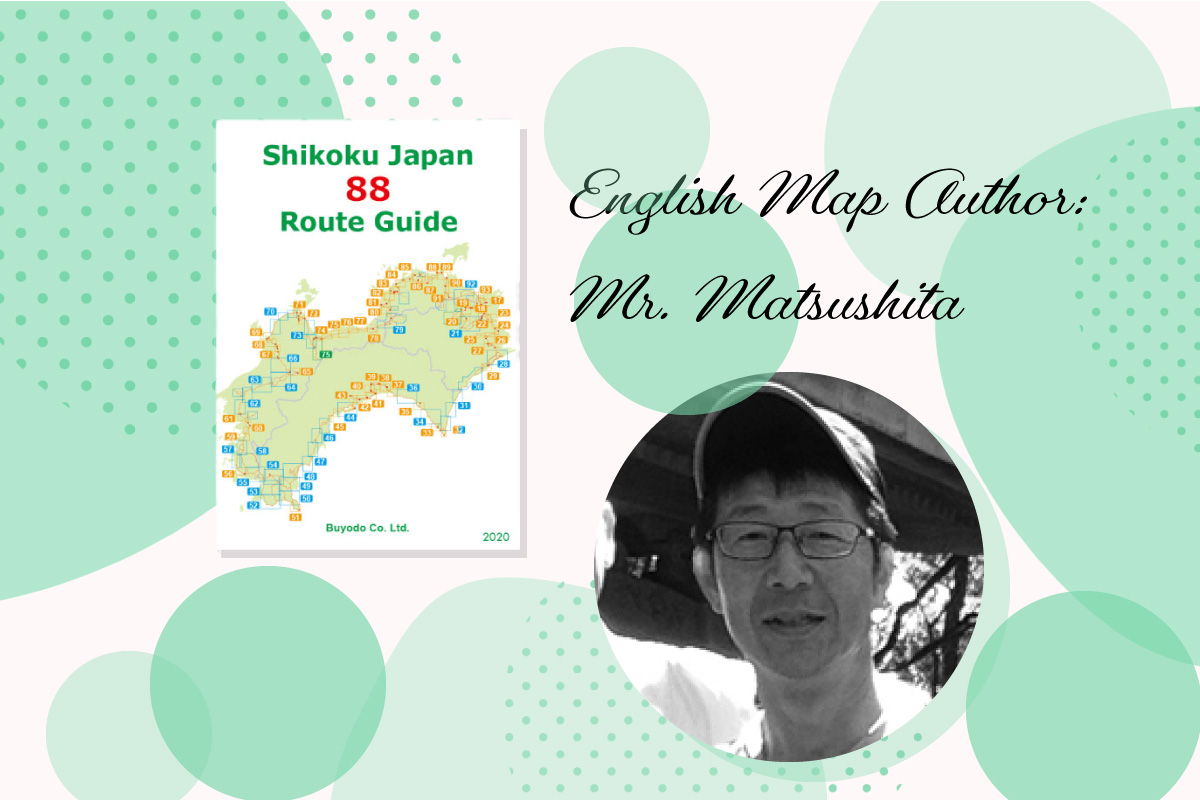
We asked the author of the Shikoku Japan 88 Route Guide how it came to be published!
As mentioned in the “Guidebooks” section of this website, many foreign pilgrims carry the “Shikoku Japan 88 Route Guide” with them. It is a long-selling English-language book that provides all the information necessary for the Shikoku Pilgrimage on maps. It includes the distance and elevation of temples, how to get there by public transportation, and the etiquette for visiting temples.
The first edition of this guidebook was published in 2007. Since then, it has undergone numerous revisions, and the 8th edition will be released in February 2023. Hearing this, we decided to interview the author, Naoyuki Matsushita, about the past 15 years.
Although the Shikoku Pilgrimage has now become widely known overseas, but 15 years ago, there were still very few foreign pilgrims. Even if you had taken the time and expense to publish an English map version, you probably wouldn’t have had much chance of selling it. Mr. Matsushita, why did you decide to publish it?
(Interviewer: Kota Murao, Shikoku Pilgrimage Information Center)

Naoyuki Matsushita was born in 1961. After graduating from university, he joined Buyodo, a map production and printing company, where he was involved in the production of all kinds of maps, including GSI maps, sightseeing maps, and geological maps. In 2004, he was transferred to Takamatsu Branch. Since then, he has immersed himself in the Shikoku Pilgrimage, and based on his research, he has published Shikoku Japan 88 Route Guide as an author, editor, and cartographer for Buyodo in 2007. He retired in 2022 and now spends his days in Osaka, living in peace while often walking in Shikoku and continuing to research and update information on the pilgrimage routes. He is a land surveyor and a board member of NPO Ohenro Lab.
“If the company pays only for the printing costs, we can manage to do it,” thought Mr. Matsushita.
Since this is the first revision in three years, have there been many changes in the maps?
I usually revise the book every 2 years, but it became 3 years this time.
Due to COVID-19, there were fewer people visiting Shikoku. Also, the information has frequently changed due to various changes, such as the temporary closure of accommodations. We really were at the mercy of COVID-19.
Nowadays, we see many foreign pilgrims, but when the book was first published in 2007, foreign pilgrims were only a few enthusiasts, right? Wasn’t it difficult to expect the book to sell?
That’s right. I was transferred to Takamatsu in 2004. Then, I was commissioned by the Organization for Promotion of Tourism in Shikoku (at that time, known as Shikoku Prefectural Tourism Promotion Council) to create multilingual pamphlets on the Shikoku Pilgrimage. They liked pamphlets so much that in 2006 they asked me if I could make detailed pilgrimage maps for foreigners. However, no matter how I thought about it, I could not do it within their budget. It would not have been profitable to publish it at Buyodo.
I can imagine. I am surprised you made it.
I have always loved hiking in the mountains and cycling. After being transferred to Shikoku, I got hooked on the pilgrimage. Since I was in the publishing business, I wanted to publish a book about it someday. After consulting with the Organization for Promotion of Tourism in Shikoku, I was told that if Buyodo published the book, they would purchase a portion of the first edition. And if I draw the maps free of charge, the company would only have to pay for printing, paper, and binding, so I wouldn’t cause much trouble for them. So I decided to publish it.
Through my work, I also met Professor Gorge Moreton of Tokushima University (at that time, Tokushima Bunri University). He agreed to translate and check the contents at a very reasonable price as part of his research and gave me various ideas.
Well, but at the time, we thought selling 50 copies a year would be the best we could do and were prepared to make a loss.
So, you had a lot of support.
I am a cartographer, so I can draw maps. However, I needed help regarding the information on the Shikoku Pilgrimage. So, I went to Mr. Tateki Miyazaki, author of Shikoku Pilgrimage Walking Alone, Dōgyō Ninin, to ask if we could use the information from his book.
His book is still the bible for pilgrims. As I read it at that time, I was greatly impressed by his depth of knowledge, persistence obsession, and love for the walking pilgrimage. I was turned down many times, but I did not give up. After many twists and turns, he allowed us to use the information free of charge. He said, “If the people in the world would know about the faith in Kobo Daishi, you can use it.”
That is an exciting story.
With everyone’s help, we were able to publish the first edition. However, since it is such a niche book, we could not get it placed in any bookstores as expected. We put it on Amazon, but it did not sell at all. We relied on the Pilgrimage Preservation Society as our sales channel.
At the time, Mr. Matsushita was 46 years old and a veteran cartographer, but he was not satisfied with the quality of the first edition. Motivated to revise the book, he disposed of much of the first edition. He published a second edition two years later. Since then, the book has gradually gained recognition, and now a new edition is published every two or three years whenever the stock runs out. The 7th edition is still in store due to COVID-19. Still, the 8th edition is scheduled to be published following the easing of immigration restrictions in Japan.
“Walk through mountains covered with cobwebs and bushes”
While there will be some opening and closing of inns and facilities each year, the pilgrimage route won’t change much, will it?
There is no official route for the Shikoku pilgrimage. The routes are based on the paths that pilgrims have walked, mentioned in publications, or recommended by Mr. Miyazaki and others in their research. We will proactively reroute if roads change or if history or necessity dictates a better route. So, in general, the total distance of the pilgrimage route is said to be 1200 km. Still, it varies depending on the period and the route chosen. Some roads are also disappearing or have already disappeared because no one walks on them.
You studied geography at university and are also a surveyor, right?
Yes, that’s right.I still come to Shikoku to survey the pilgrimage routes and their surroundings to check the conditions. I sometimes run 70 kilometers a day for surveying and marathon training as my hobby, walk through mountains covered with cobwebs and bushes, and listen to stories from elderly locals. Now the total distance of the walking route is 1,137 kilometers by my calculation.
You’ve seen it all with your own eyes, right? And many times, too. I can only say that it is impressive.
For me, the Shikoku Pilgrimage is a research subject with a geographical approach. The geographic information from my research is entered into GIS software to create a database. The level of accuracy is equivalent to a scale of 1/2500, and the location of buildings can be identified. I scrutinize the information of public interest and publish it in a book. However, since it is research for me, I also include information that may not be of interest to others, such as small ★ marks (pilgrimage huts and monuments) on the map.
The more you continue your research, the more information you will get, right? Wouldn’t you want to add more pages?
Due to budget constraints, we can’t increase the number of pages. But, we actively incorporate new findings and suggestions from users. That’s why the pagination changes with each revision. Also, I provide information that can’t fit in the book on my own site or the sites of trusted friends.
This site is also possible thanks to your results and Mr. Miyazaki’s research on which it is based. We are very grateful.
We want people not only in Japan but around the world to know about this treasure.
We hope that the local people will also benefit from the pilgrims from abroad, which is why we are working on this project. We look forward to seeing your continued success.
Finally, Mr. Matsushita has a message for those thinking about making a walking pilgrimage.
In the pursuit of economy and efficiency, people today may have forgotten what is important to them as human beings. On a walking pilgrimage, you will have heartwarming conversations with strangers and feel as if you are blessed by the beautiful nature that surrounds you.
Naoyuki Matsushita
Such an environment nurtures Jiri Rita ‘s spirit and makes us kind to all things. I hope many people will experience this sense of fulfillment in Shikoku, where the ancient pilgrimage culture remains strong.
The Jiri Rita is a mind capable of thinking from the perspective of others while controlling your own desires. It can also be translated as the heart of pilgrims.
For pilgrims, Shikoku is a sacred place of ascetic practice. The world is more challenging than to make wishes come true just by walking.
The Shikoku pilgrimage is to be grateful for the trials of inefficiency, discomfort, anxiety, scarcity, and danger. It is to endure inconvenience, to be helped by the compassion of others, and to put ourselves in other people’s shoes.
I believe that the speed of human thought matches the speed of walking. If you blend into the natural environment, your sensitivity will be refined. Please, have a wonderful experience in Shikoku. I wish you a safe trip.


